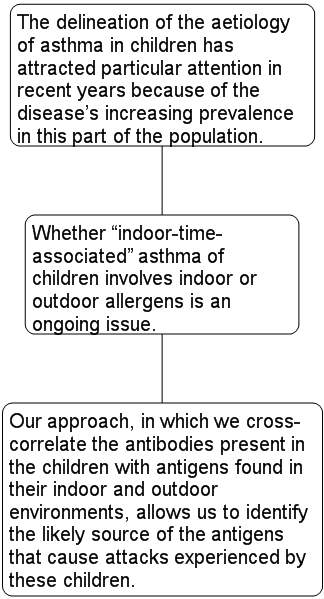The Science Of Scientific Writing Set E Generic Sections Maps as Section Blueprints Exercise 1 Exercise 2 ImRaD Methods : Structure Methods: Coherence Exercise 3 Final Page .
OVERVIEW: The way to well-written science
PART I: Paragraphs and Sentences
SET A: Paragraphs: The Maps Behind Them
SET B: Paragraphs: Using Maps to Meet Readers' Expectations
SET C: Paragraph Coherence and Cohesion
SET D: Sentences
SET E: Scientific Sections (including Methods)
SET F: Scientific Sections: The Discussion
SET G : Scientific Sections: The Introduction
SET H : The Paper as a Whole
The map as a blueprint for a generic section
Some of you might feel that paragraphs are short enough to write up without the assistance of a map, but sections obviously present a greater challenge, and some sort of "blueprint" or outline is invaluable. And now that you understand how to make a map for a paragraph, a section map is a piece of cake!
There are two ways to use section maps:
1. For a section you have already written.
You might find it useful to create a map of your section as a summary for a colleague who is helping you with the paper. Alternatively it can be a means by which you can confirm that the section flows. Start by marking the landmark sentence of each paragraph in some wa, as below:
Asthma is one of the most debilitating of respiratory diseases. The delineation of its aetiology in children has attracted particular attention in recent years because of the disease’s increasing prevalence in this part of the population. During the last three decades, the incidence of asthma in children, especially in the developed world, has continually risen (Koff et al., 2004). For example, it has recently been estimated that by the age of fourteen, 25% of all children in Australia will have suffered at least one asthmatic attack (Krokodyal and Dundee, 2001).
The reasons for the increasing prevalence of asthma are unclear. Several studies have demonstrated that time spent indoors correlates strongly with the incidence of childhood asthma (e.g. Ceeger and Neentendough, 1988), and Durstmeight (1990) has proposed that prolonged exposure to household allergens could be important. But it has not yet been shown definitively that indoor allergens are responsible. Recently Ghetarlyfe (2003) has suggested that it is decreased time spent outdoors that is possibly the causative factor. In this as yet untested scenario it would be outdoor, not indoor, allergens that are responsible: children might be getting fewer opportunities to develop an insensitivity to agents such as pollen and fungal spores that occasionally reach high densities, since they not being exposed to them at low levels. Thus whether “indoor-time-associated” asthma of children involves indoor or outdoor allergens is an ongoing issue.
To address this question, we have followed up the group of 5,000 children originally surveyed by Ceeger and Neentendough (1988). Our approach, in which we cross-correlate the antibodies present in the children with antigens found in their indoor and outdoor environments, allows us to identify the likely source of the antigens that cause attacks experienced by these children.
Now, put each in a box, and connect them up in a map. You may need to add in a few words to clarify conent that is not directly mentioned (e.g. in the first box of the map below the word "its" in the original has been replaced by "of asthma").

2. For a section you have yet to write.
In constructing a map for a section that we want to write, we use one box per expected paragraph, and in each box we put the basic content that will be used for each paragraph's landmark sentence. For example the map below might have been used to plan the asthma paper Introduction above:

Notice that as we work our way through the map, adjacent boxes share key words: asthma, childhood, children, indoor, outdoor etc. Inexperienced writers often feel that they should never repeat important words, and anxious that the reader will be bored, they head to their thesaurus to hunt down different-sounding synonyms. But in reality, if you use exactly the same terms in the key sentences of your writing (i.e. the Pointer and Landmark Sentences), you will create a sense of continuity and coherence in the text.
......